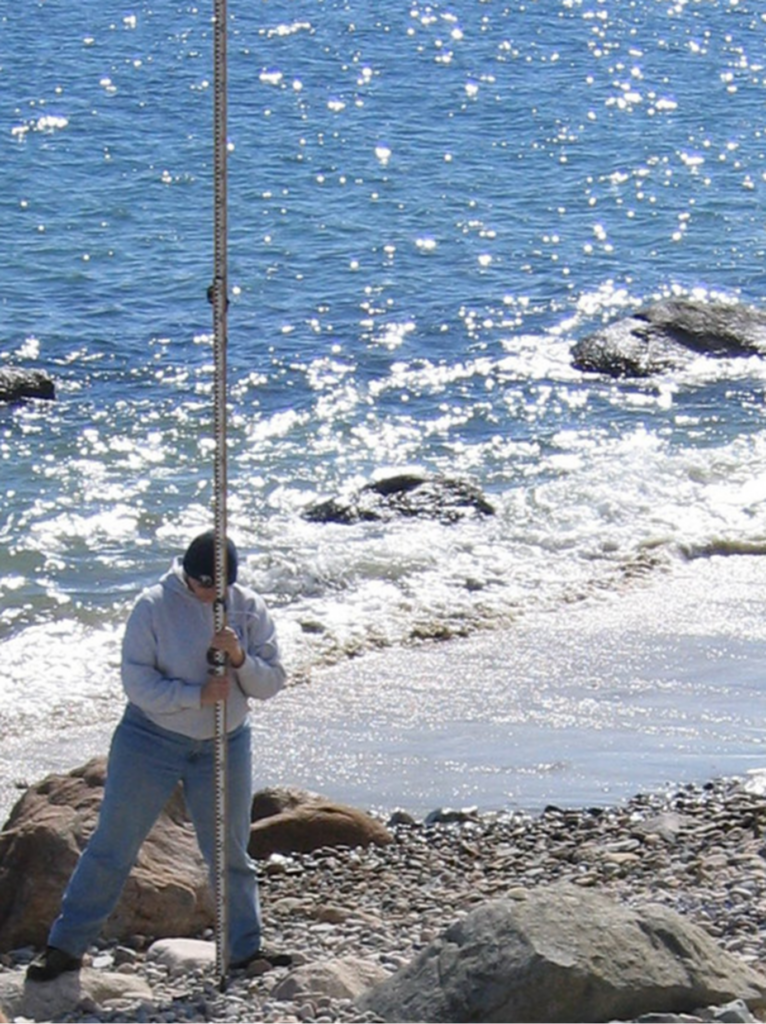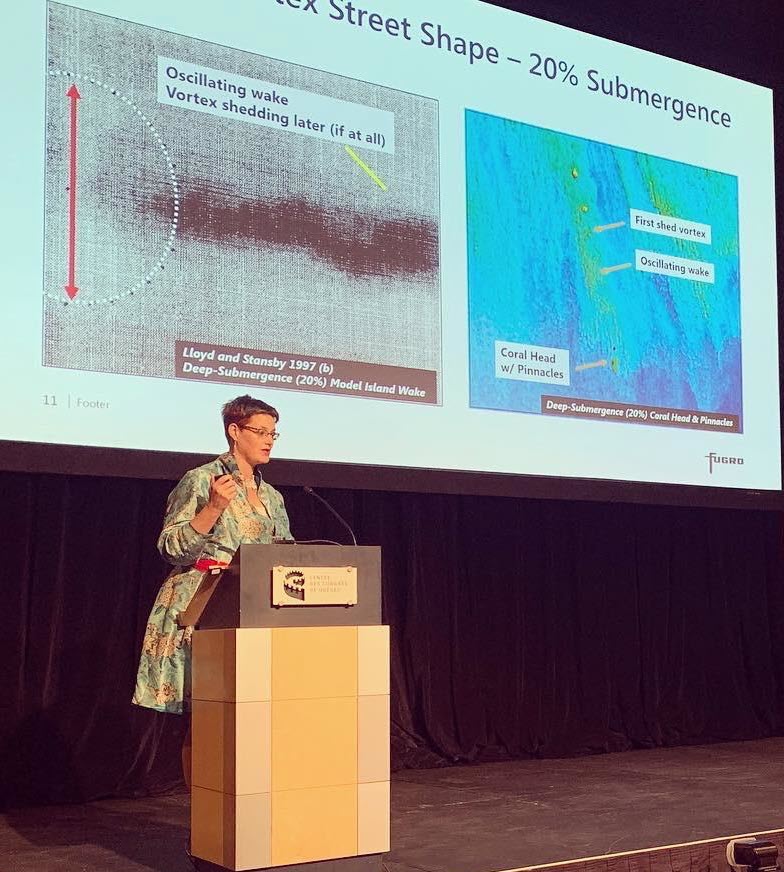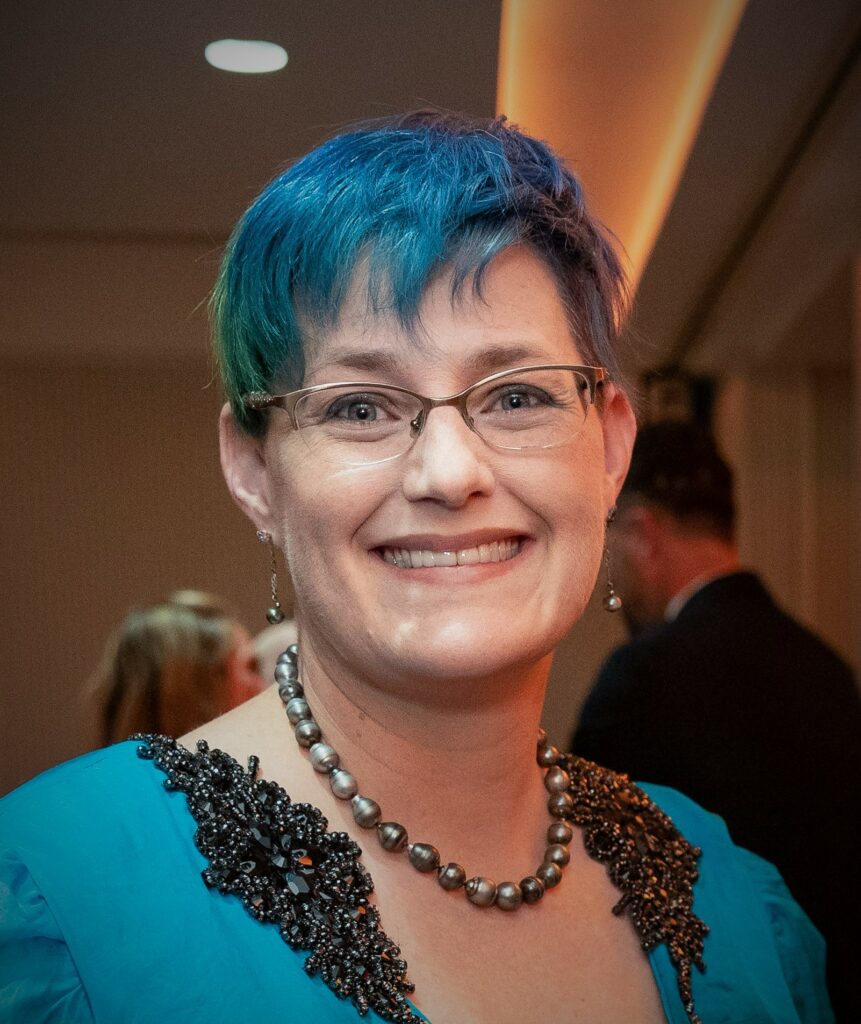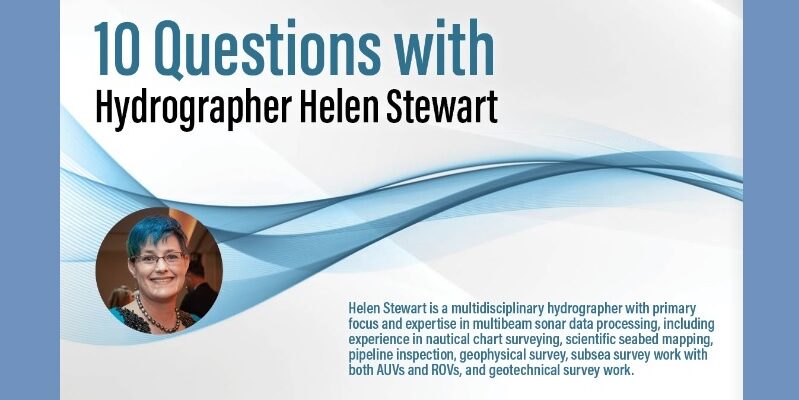Helen Stewart is a multidisciplinary hydrographer with primary focus and expertise in multibeam sonar data processing, including experience in nautical chart surveying, scientific seabed mapping, pipeline inspection, geophysical survey, subsea survey work with both AUVs and ROVs, and geotechnical survey work.
How did you get interested in hydrography. Did a specific event trigger your interest or is it something that evolved over time?
It’s a combination of things. My father has a degree in geography, so I grew up drawing “maps” like the ones in his Goode’s World Atlas. Then when I was a child, I was standing near the shore watching ships go into port and I told my parents, that’s what I’m going to do when I grow up. When I got to university, I discovered nautical charts, and that’s when the lightbulb lit up. I thought, “Wait, I can do this for real?” And now here I am.
Your work has taken in many different aspects of hydrography, from charting, geophysical, and deepwater AUV projects to marine construction and oceanographic research. Is there a particular aspect of hydrography that you really get excited about?
Believe it or not, inland hydrography. Starting in 2018, I began working on a novel method of using multispectral satellite imagery to detect hazards to navigation by identifying and classifying the turbulent structures on the water’s surface caused by these hazards. For a variety of reasons, these structures are easier to identify in satellite imagery in rivers or enclosed channels.
I recently worked on a joint pilot project with the National Research Council of Canada (NRC), using the novel hydrographic method in the St. Lawrence River. Building on the success of the pilot project, the NRC’s principal investigator and I are currently evaluating potential opportunities for other inland waterways in Canada. In addition to that research, the type of hydrographic surveying for inland structural health monitoring is very challenging and complex, and I appreciate the challenge.

Helen Stewart as a young hydrographer in 2004
This is the Ocean Decade and many xyHt readers’ careers may be more connected with the land. Why should they and everyone else be interested in the Ocean Decade?
A healthy society depends on a healthy ocean. We all depend on water, whether it’s in inland waterways, the ocean, ground water, or the water falling from the sky. We all depend upon goods that are transported on the ocean. We all depend upon electrical power that comes from the water, whether it’s hydroelectric power, offshore oil and gas, ocean thermal energy, or offshore wind energy. We all depend upon food from the world’s water bodies, directly in the form of fish or shellfish or edible seaweeds, or indirectly by use of seaweed as fertilizers.
But what the ocean gives us, it can also take away. Rising sea levels are existential threats to coastal communities, not just as some distant point in the future but right now. There are coastal communities in Alaska and Louisiana that have begun relocating farther inland as rising water levels have made it impossible for people to safely live there anymore.
Rising water temperatures and increased fishing pressure are causing collapses in wild fish stocks, which means that people can’t eat high-quality protein foods. Fertilizer and pesticide use from industrial agriculture and maintaining pristine green lawns causes harmful algal blooms in fresh and salt water, meaning that people cannot drink their tap water, as happened recently in Toledo, Ohio, which gets its drinking water from Lake Erie, or “dead zones” form in the Gulf of Mexico and kill fish and shellfish, which again affects peoples’ ability to eat affordable high-quality protein foods. Increased atmospheric heat and moisture content caused by greenhouse gas emissions is leading to larger, stronger tropical cyclones and a collapse of local atmospheric steering currents, which is what led to me having 42 inches of rain in four days at my house in Houston during Hurricane Harvey in 2017.
The Ocean Decade is our opportunity to educate ourselves about what conservation for a healthy ocean means, to find scientific partners and funding opportunities, to develop the scientific practices we need to live safely and with dignity at the boundary of land and sea, and to set policies to do our part as society in having a healthy ocean. We need hydrographers, oceanographers, and marine biologists, yes, but we also need people who are experts in more traditional terrestrial areas.
How do we understand coastal erosion patterns without knowing where the coast was? Land surveyors, we need you.
How do we understand changes in coastal flooding patterns without knowing historical inundation patterns or how to build structures to minimize wave damage to roads? GIS experts and civil engineers, we need you.
Hydrographers can establish a local tidal datum, but how do we tie that into existing local and global datums? Geodesists, we need you.
And if you are a person who knows how to explain complex scientific problems to non-scientific stakeholders, then no matter what your field is, we need you.

Helen Stewart presenting her original research at the 2020 Canadian Hydrographic Conference.
You were somewhat of a pioneer as a woman in hydrography, and now you’re deeply involved in empowering women in hydrography. Why should women be excited about hydrography as a career?
Women have worked as hydrographers and oceanographers for close to a century and have made massive contributions to these professions. Mary Sears created hydrographic survey products and tide tables for the U.S. Navy in the World War II. Marie Tharp drew her map that led to scientific acceptance of continental drift in 1957. Irene Fischer, one the most accomplished geodesists of the late 20th century, independently recalculated the oblateness of the Earth, which was later confirmed by observations from Sputnik and the Mercury missions. Her work was instrumental in creating the WGS84 reference system. Gladys West, a geodesist best known for precisely calculating the geoid model that is the basis for GPS, also led the first processing lab for satellite-based radar altimetry, which has been hugely significant to modern hydrography.
They and their colleagues created the career path in hydrography that I now walk upon. It’s my turn now to carry that torch and use it to light the path for others behind me to follow.
As for why women, or anyone else, should be excited about hydrography as a career, it’s a profession where math, science, engineering, and art all come together. It’s a key step in the path to clean power for our future. It is essential toward having that safe and dignified life at the edge of land and sea I referred to.
And hydrography is cool. I made maps of the ocean floor with a robot submarine. I created works of art—nautical charts—that translated stories told by sonars and instruments into words and images that mariners use to travel safely. I have found shipwrecks, mud volcanoes, and hot water vents 3,000 feet below the ocean surface. Now that I no longer go into the field, I use pictures from satellites to tell me where dangerous rocks are hiding under the ocean surface or where erosion around bridges might be occurring. Who wouldn’t be excited about that?
What are the biggest barriers to getting more women involved?
First of all, let’s be clear about why organizations should make an effort to bring in women—if you need people, and you are arbitrarily excluding women from your organization, you are making your own mission harder for no good reason. The same is true for people from racial or ethnic minority groups, linguistic minority groups, gender and sexuality minority groups, and neurodiverse people.
If we want our organizational missions to be successful, we all need to learn to challenge our own mental shortcuts about what talented people “look like,” and learn to look at the talented people in front of us. That’s what I mean by arbitrary exclusions. Case in point: if I were to introduce you to a religious minority refugee mother of two working as a seamstress’ assistant to make ends meet, what is your first reaction? Do you bother to look at her professional credentials, or do you mentally think, “Nope, next?”
One of the biggest barriers to women’s participation in hydrography is that we don’t know what we don’t know—how many women entering the workforce don’t know what hydrography is?
I grew up in a house with a trained geographer and maps everywhere, and I knew I wanted to go to sea even as a child, and despite that I didn’t know that nautical charts existed until I was in university. This is not unique to hydrographic surveying, nor is it unique to women. Geodesy and land surveying are having similar challenges of getting people in the door, full stop.

Helen Stewart
How do you tear those barriers down?
What this means for organizations on multiple levels, from secondary education to universities to public and private sector groups, is that they must go look for women. Make education and outreach materials, and make sure they include photos of women working and quotes from women. If you are doing recruiting, make a point of finding women and talking to them. Look for women in hydrographic survey-adjacent fields like GIS, marine biology, or oceanography, or in compatible disciplines like mathematics. Look for women who served in the Navy or Coast Guard and who would like to continue working in the maritime sector and look for women in community college or high school math programs who may not go to a four-year university for whatever reason. When you go out recruiting, include women on your recruiting team. Showing someone that this career path is open to people who are like you is much more powerful than telling them. Look for talented people of color, religious or linguistic minorities, gender and sexuality minorities, and neurodiverse people.
Remember that this is about having talented people to fulfill your organization’s mission. Diversity initiatives get talented people in the door. Equity and inclusion initiatives are what get them to stay.
Oh, and that religious minority refugee mother of two working as a seamstress’ assistant that I mentioned earlier? That is Irene Fischer. Her work changed the world. It takes a lot of humility and self-awareness to let go of our internal preconceived notions about who can be a surveyor or a hydrographer, and it’s worth it to do so because the rewards are so high.
Because of the decline in the workforce population, many professions are having a hard time recruiting and retaining workers. Is there even more of an opportunity for women in hydrography today?
There is as much as an opportunity for women as we in the profession are currently willing to give them. Hydrographic surveying is a growth industry—the jobs are there, the research is there—but if we do not as a profession commit to diversity, equity, and inclusion efforts, women will make the rational decision to look for other professions that welcome them.
One area of hydrographic surveying that is rapidly evolving and that I’m thrilled to see is the dawn of over-the-horizon remote surveying. Going to sea is a barrier for a lot of people in general. The physical constraints of pregnancy, nursing, and care work can either dissuade women in particular from entering hydrography in the first place, or can force a talented, skilled person out of the profession just as she is reaching a key point in her career.
What if we didn’t have to do that? What if we did not have to resign ourselves to losing the talents and skills of women who want to do a very, very normal thing that humans do? For that matter, what if we did not have to lose the talents and skills of men who would leave the profession because those men want to be better partners and parents? If male parents are available to do their share of care work, it gives female parents more room to advance in their careers. This is good for everyone.
We have to be mindful about creating equitable over-the-horizon and remote work policies, though. If we remove the barrier of going to sea, we can use that to convince women to stay in the profession. But if we create remote survey or processing roles but professional advancement is limited to people who go offshore, we are not actually removing barriers to women’s participation, we’re only changing the paint job on the brick wall. This is one example of what I mean when I say, there’s as much opportunity for women in hydrography as we are willing to give them.
Safety is a big issue as well. Is the industry making strides in this regard?
In some cases, yes, in others no. Where the industry can improve on its own, in general it is moving in that direction. There are other aspects of safety that will require concerted national and international effort to change.
There have been demonstrable improvements in some aspects of health and safety for women in the hydrographic workplace. I have been working with professional bodies, universities, and government officials to make immediate changes, like making sure that every person coming on board has a survival suit in their size. I have been working with my company’s safety team to make sure that women have female-fit coveralls, gloves, and appropriate berthing and hygiene facilities. This is great, and I encourage all organizations to make safety changes.
For safety changes that need to come, although women have been going to sea for more than 50 years, marine survival suits have never been thermally tested or fit-tested for women’s bodies. For that matter, they have never been thermally tested on several types of men’s bodies, such as older men like a lot of ship’s captains or very small-bodied men like the seafarers from the Philippines or Malaysia who deserve safe working conditions, too.
Getting new suits designed, tested, and approved will take years of work and the International Maritime Organization will need to pass new carriage regulations for seafarers. This is not something individual organizations can do on their own. I encourage organizations of all types to support legislation to fund new survival-suit designs and thermal testing, and in the long run to support efforts to rewrite international carriage requirements for new, safer survival suits.
What are some initiatives and activities happening now that can contribute to a diverse and equitable hydrospatial workforce?
A big one is the Empowering Women in Hydrography Project (EWIH), which is sponsored by the International Hydrographic Organization (IHO) and is recognized as part of the UN Ocean Decade. The EWIH Project was founded by women at the Canadian Hydrographic Service and has spread to other hydrographic offices, research and academic institutions, and private companies around the world. That’s a good place to start. I have written a pair of white papers for the International Hydrographic Review, on suggestions for the IHO itself and the government agencies that are members. Other IHO member states have written papers about their participation.
Other than EWIH, there are a few other notable initiatives out there. In the United Kingdom, there is a group called the AXIS Network, which created an integrated offshore workforce task force and published position papers and posts on people’s experiences. It’s a useful resource and the AXIS website contains links to smart steps toward building inclusive workplaces.
Also based in the UK is a group called the Trades Union Congress, which has a long, detailed, thoroughly researched list of specific steps organizations can take to become safer and more equitable. Neither AXIS nor the Trades Union Congress are dedicated to hydrography, but don’t let that stop you from looking into what they’ve done. Finally, there is a group called Women Offshore that provides mentoring and career advice, as well as diversity, equity, and inclusion training.
Describe the hydrographer of tomorrow?
I don’t see a single template for what hydrographers in the future look like. I see a lot of different people. All of them will have an understanding of datums, positioning, marine physics, and principles of mapping in common, whether it’s taught in university or learned on the job. Once we have that common reference frame, we can fit the rest of our fascinatingly varied profession into it, and we can find ways for the fascinatingly varied people to take their place in that profession.

